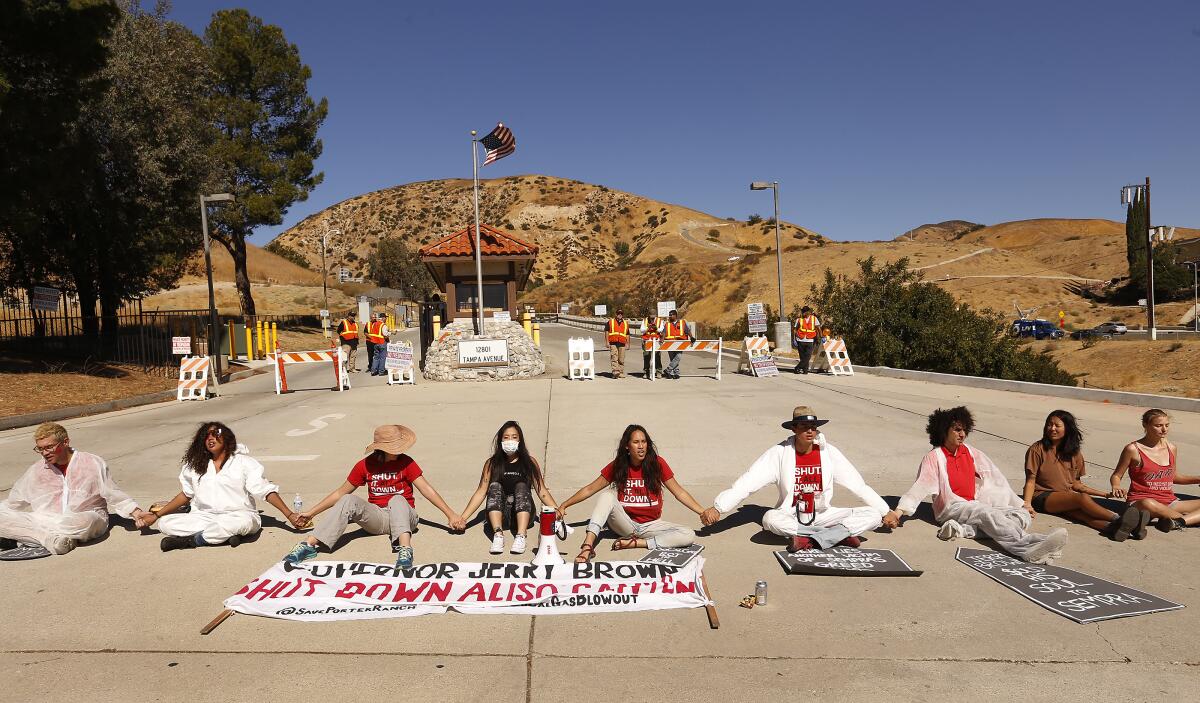Editorial: A billion-dollar settlement can’t erase the Aliso Canyon methane blowout

With the announcement Monday that Southern California Gas and its parent company will pay up to $1.8 billion to settle claims of residents and businesses affected by the 2015 Aliso Canyon blowout, it’s worth remembering just how much the disaster rocked the Porter Ranch community.
What was initially reported as a small routine leak at a little-known underground natural gas storage field turned out to be the largest methane leak in U.S. history — right next to a residential community.
The impact was felt immediately. The sickening smell of the gas could be picked up for miles. People living and working in the area suffered from nausea, nosebleeds, rashes and breathing problems, among other symptoms. It was so bad that more than 8,000 families had to pack up and move temporarily. As the leak dragged on, an oily mist fell on the surrounding neighborhoods, and residents were warned to stay inside. Schools were relocated for a period to get kids farther from the blowout.
It took four months for SoCalGas to plug the well. By then, the leak had released more than 100,000 metric tons of methane, along with a cocktail of other chemicals, including toxic gas and particles. Methane is a potent greenhouse gas. The state has estimated the effects of the leak were equivalent to the carbon dioxide emissions released from burning more than 1 billion gallons of gasoline.
Even now, nearly six years later, some residents continue to suffer from nosebleeds, dizziness and respiratory problems. SoCalGas was required to pay $25 million for a study on short- and long-term health effects of the blowout as part of a 2019 settlement with city, county and state authorities. But the community is still waiting for Los Angeles County to start the study, and there are now concerns that analysis will be incomplete because the county will not compel SoCalGas to turn over data on the chemicals released during the blowout.
The $1.8-billion settlement is, by no means, a resolution of the Aliso Canyon saga. (The settlement itself is still tentative; it will be finalized if 97% of the 36,000 individual plaintiffs agree to the terms.)
Residents are still waiting for clarity on what will happen to the gas field. Then-Gov. Jerry Brown’s administration said in 2017 that the facility’s natural gas storage would be phased out in a decade. Gov. Gavin Newsom announced in 2019 that he wanted to fast-track the shutdown. But the California Public Utilities Commission is studying what it will take to close Aliso Canyon no sooner than 2027 — or as late as 2035, a decade before California is supposed to transition to 100% clean power. The PUC is also considering letting SoCalGas increase gas storage at the Aliso field above current levels.
Newsom cannot back down on his promises. California has to move much faster to reduce its dependence on natural gas and eliminate the need for Aliso Canyon’s gas storage.
Residents affected by the blowout deserve every penny of compensation from SoCalGas. But let’s be clear — the settlement won’t return the sense of security and peace that people felt in their homes before the blowout. The money doesn’t erase the environmental impacts from the blowout. And it doesn’t absolve California leaders of fulfilling their promises to the community.
More to Read
A cure for the common opinion
Get thought-provoking perspectives with our weekly newsletter.
You may occasionally receive promotional content from the Los Angeles Times.










